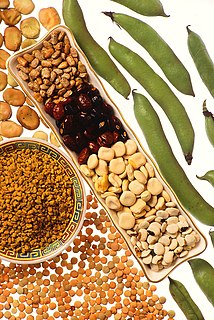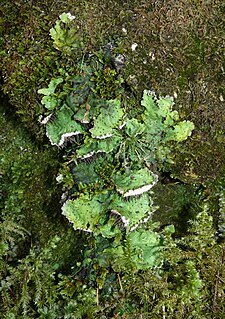
A kitten is a juvenile cat. After being born, kittens are totally dependent on their mother for survival and they do not normally open their eyes until after seven to ten days. After about two weeks, kittens quickly develop and begin to explore the world outside the nest. After a further three to four weeks, they begin to eat solid food and grow adult teeth. Domestic kittens are highly social animals and usually enjoy human companionship.

Dietary fiber or roughage is the portion of plant-derived food that cannot be completely broken down by human digestive enzymes. It has two main components:

A raisin is a dried grape. Raisins are produced in many regions of the world and may be eaten raw or used in cooking, baking, and brewing. In the United Kingdom, Ireland, New Zealand, and Australia, the word "raisin" is reserved for the dark-colored dried large grape, with "sultana" being a golden-colored dried grape, and "currant" being a dried small Black Corinth seedless grape.

A food pyramid or pyramid is a representation of the optimal number of servings to be eaten each day from each of the basic food groups. The first pyramid was published in Sweden in 1974. The 1992 pyramid introduced by the United States Department of Agriculture (USDA) was called the "Food Guide Pyramid" or "Eating Right Pyramid". It was updated in 2005 to "MyPyramid", and then it was replaced by "MyPlate" in 2011.
In the context of nutrition, a mineral is a chemical element required as an essential nutrient by organisms to perform functions necessary for life. However, the four major structural elements in the human body by weight, are usually not included in lists of major nutrient minerals. These four elements compose about 96% of the weight of the human body, and major minerals (macrominerals) and minor minerals compose the remainder.

A legume is a plant in the family Fabaceae, or the fruit or seed of such a plant. Legumes are grown agriculturally, primarily for human consumption, for livestock forage and silage, and as soil-enhancing green manure. Well-known legumes include alfalfa, clover, beans, peas, chickpeas, lentils, lupins, mesquite, carob, soybeans, peanuts, and tamarind. Legumes produce a botanically unique type of fruit – a simple dry fruit that develops from a simple carpel and usually dehisces on two sides.

Crotalaria is a genus of flowering plants in the legume family Fabaceae commonly known as rattlepods. The genus includes about 500 species of herbaceous plants and shrubs. Africa is the continent with the majority of Crotalaria species, which are mainly found in damp grassland, especially in floodplains, depressions and along edges of swamps and rivers, but also in deciduous bush land, roadsides and fields. Some species of Crotalaria are grown as ornamentals. The common name rattlepod or rattlebox is derived from the fact that the seeds become loose in the pod as they mature, and rattle when the pod is shaken. The name derives from the Ancient Greek κρόταλον, meaning "castanet", and is the same root as the name for the rattlesnakes (Crotalus).

Morus alba, known as white mulberry, is a fast-growing, small to medium-sized mulberry tree which grows to 10–20 m (33–66 ft) tall. It is generally a short-lived tree with a lifespan comparable to that of humans, although there are some specimens known to be over 250 years old. The species is native to northern China and India, and is widely cultivated and naturalized elsewhere.

A plant-based diet is a diet consisting mostly or entirely of foods derived from plants, including vegetables, grains, nuts, seeds, legumes and fruits, and with few or no animal products. A plant based-diet is not necessarily vegetarian. The use of the phrase plant-based has changed over time, and examples can be found of the phrase "plant-based diet" being used to refer to vegan diets, which contain no food from animal sources, to vegetarian diets which may include dairy or eggs but no meat, and to diets with varying amounts of animal-based foods, such as semi-vegetarian diets which contain small amounts of meat. The Academy of Nutrition and Dietetics issued a position statement proposing that well-planned plant diets support health and are appropriate throughout life, including pregnancy, lactation, childhood, adulthood, and for athletes.

Fat choy is a terrestrial cyanobacterium that is used as a vegetable in Chinese cuisine. When dried, the product has the appearance of black hair. For that reason, its name in Chinese means "hair vegetable". When soaked, fat choy has a soft texture which is like very fine vermicelli.

Nostoc is a genus of cyanobacteria found in various environments that forms colonies composed of filaments of moniliform cells in a gelatinous sheath.

Peltigera is a genus of approximately 91 species of foliose lichens in the family Peltigeraceae. Commonly known as the dog lichen, lichens of Peltigera are often terricolous, but can also occur on moss, trees, rocks, and many other substrates in many parts of the world.

Theanine, also known as L-γ-glutamylethylamide and N5-ethyl-L-glutamine, is an amino acid analogue of the proteinogenic amino acids L-glutamate and L-glutamine and is found primarily in particular plant and fungal species. It was discovered as a constituent of green tea in 1949; in 1950, it was isolated from gyokuro leaves. Theanine provides a unique brothy or savory (umami) flavor to green tea infusions.

Papuacedrus papuana is a species in the conifer family Cupressaceae, the sole species in the genus Papuacedrus. Some botanists do not consider this species as forming a distinct genus, but include it in the related genus Libocedrus. It is native to New Guinea and to the Indonesian Province of Maluku.

Thomas Colin Campbell is an American biochemist who specializes in the effect of nutrition on long-term health. He is the Jacob Gould Schurman Professor Emeritus of Nutritional Biochemistry at Cornell University.

Isomaltulose is a disaccharide carbohydrate composed of glucose and fructose. The glucose and fructose are linked by an alpha-1,6-glycosidic bond. Isomaltulose is present in honey and sugarcane extracts. It tastes similar to sucrose with half the sweetness. Isomaltulose is also known by the trade name Palatinose, which is manufactured by enzymatic rearrangement (isomerization) of sucrose from beet sugar. The enzyme and its source were discovered in Germany in 1950, and since then its physiological role and physical properties have been studied extensively. Isomaltulose has been used as an alternative to sugar in foods in Japan since 1985, in the EU since 2005, in the US since 2006, and in Australia and New Zealand since 2007, besides other countries worldwide. Analytical methods for characterization and assay of commercial isomaltulose are laid down, for example, in the Food Chemicals Codex. Its physical properties closely resemble those of sucrose, making it easy to use in existing recipes and processes.
A sustainable food system is a type of food system that provides healthy food to people while also providing sustainable impacts on both environmental, economic and social systems that surround food.

Enterolactone is a chemical compound formed by the action of intestinal bacteria on plant lignan precursors present in the diet.

Vegan nutrition refers to the nutritional and human health aspects of vegan diets. A well-planned, balanced vegan diet is suitable to meet all recommendations for nutrients in every stage of human life. Vegan diets tend to be higher in dietary fiber, magnesium, folic acid, vitamin C, vitamin E, iron, and phytochemicals; and lower in dietary energy, saturated fat, cholesterol, long-chain omega-3 fatty acids, vitamin D, calcium, zinc, and vitamin B12. Preliminary evidence from epidemiological research indicates that a vegan diet may lower the risk of cancer.

Nostoc commune is a species of cyanobacterium in the family Nostocaceae. Common names include star jelly, witch's butter, mare's eggs, fah-tsai and facai. It is the type species of the genus Nostoc and is cosmopolitan in distribution.

















